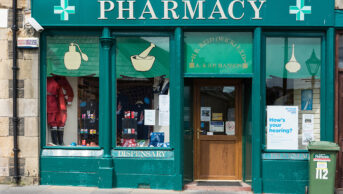
Nic Bunce / Shutterstock.com
Closures of more than 450 community pharmacies in 2020/2021 have resulted in the lowest number of pharmacies in England since 2015/2016, despite the prime minister saying he did not want any to close earlier this year.
Official NHS data reveal that the number of active community pharmacies fell from 11,826 in 2019/2020 to 11,636 in 2020/2021.
This was the result of a net loss of 215 pharmacies, with 236 new pharmacies opening during 2020/2021, while 451 closed.
In February 2021, prime minister Boris Johnson said, in response to a question on funding from The Pharmaceutical Journal, that community pharmacies played a vital role in the COVID-19 pandemic and added: “I don’t want to see any pharmacies close”.
However, despite this high-level government support, data from the NHS Business Services Authority (NHS BSA), published on 28 October 2021, show the largest net loss of pharmacies since 2015/2016, when there were 11,949 active contractors and more pharmacies opened (252) than closed (248).
This follows an analysis by The Pharmaceutical Journal last year, which found this was hitting the poorest communities disproportionately, with nearly four pharmacies closing per week in 2020 and more than four times as many closing in the most deprived parts of England than in the most affluent areas of the country.
The data from NHS BSA also showed a small (1.8%) decrease in the number of prescription items dispensed by community pharmacies from 1.04 billion in 2019/2020 to 1.02 billion in 2020/2021, some 94% of which were dispensed through the electronic prescription service.
Mike Dent, director of NHS funding at the Pharmaceutical Services Negotiating Committee, said: “Any pharmacy closure is a loss to the community it serves. The pressures experienced during the COVID-19 pandemic have been some of the toughest that community pharmacy has ever faced, and NHS funding continues to put many contractors under intolerable financial strain.
“PSNC is concerned about the potential for continuing closures: many pharmacies are already at breaking point, and we are concerned about the impact this will have on the services they offer and on which so many people rely.”
Thorrun Govind, chair of the Royal Pharmaceutical Society’s England Pharmacy Board, said the falling number of communtiy pharmacies is “extremely sad to see”.
“Local pharmacies often serve some of the country’s more deprived communities, so we implore the Government to look long and hard about how closures might impact health inequalities,” she said.
A spokesperson for the National Pharmacy Association added: “Pharmacy closures means less capacity at a time when healthcare needs are growing and community-based provision needs to step up a gear.
“Without a fresh injection of funds, as the analysis we commissioned from Ernst & Young last year showed very clearly, this pattern will continue in England and community pharmacy will be unable to play its full role helping the NHS recover from the pandemic.”
A spokesperson for the Department of Health and Social Care said its analysis of pharmacy closures suggests the majority have taken place at a location where there is another pharmacy within 10 minutes walking distance.
The majority of closures were large pharmacy chains which aligns with announcements made about closures by those chains, they said.
“Community pharmacies make an important contribution to the NHS and have gone above and beyond in response to COVID-19 to serve their communities. 80% of the population live within 20 minutes walking distance to their nearest pharmacy,” the spokesperson added.
“We closely monitor how changes in the market impact patient access to pharmaceutical services.”
Why are so many pharmacies closing?
Community pharmacies in England are in the middle of a damaging five-year funding freeze, under their national contract with the NHS, which contrasts with rising investment in other parts of the health service.
This is leading to mass closures, with Boots previously announcing plans to close 200 pharmacies by September 2021 and a report commissioned by the National Pharmacy Association warning that more would follow if the current funding arrangements continue.
Government officials knew that under this funding freeze local pharmacies would close. Documents uncovered by The Pharmaceutical Journal in November 2020 revealed that the government was warned that the ‘Community Pharmacy Contractual Framework for 2019/20 to 2023/24’ could cause an increase in pharmacy closures because of cost pressures related to launching new services.
Yet, following negotiations for year three of the five-year contractual framework this year, the Pharmaceutical Services Negotiating Committee said it had received a “flat rejection” of additional funding for the sector from the Treasury.
READ MORE: Pharmacy ‘first ports of call’ are disappearing in struggling communities


